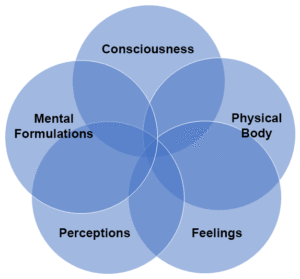“Ultimately, happiness comes down to choosing between the discomfort of being aware of your mental afflictions and the discomfort of being ruled by them.” – Yongey Mingyur Rinpoche, Tibetan Lama
A student of human nature, author Robert Wright was drawn to study mindfulness at a Buddhist meditation retreat. He deemed himself a particularly unlikely candidate for the exercise given his general restlessness and penchant for emotional expression. Yet he signed on for an immersive program that had him sit in stillness hour-upon-hour every day. Though challenging, he persevered, attended several other retreats, and wrote Why Buddhism is True: The Science and Philosophy of Meditation and Enlightenment.
Suffice it to say, the book is not light reading. It subjects 4th century BCE Buddhist dharma to 21st century evolutionary biology and neuroscience to make sense of the ancient wisdom. It also seeks to provide practical reasons to immerse oneself in the discipline of mindfulness. From pages of notes, I hope to distill some key concepts.
One of the Buddha’s core teachings is that there is no such thing as a permanent, autonomous “self.” We cannot point to any part of our being and declare that it enjoys both control and persistence. In particular:
 Our physical bodies cannot be the “self” because we have limited control over its appearance and functioning, and we certainly can’t forestall its deterioration in old age.
Our physical bodies cannot be the “self” because we have limited control over its appearance and functioning, and we certainly can’t forestall its deterioration in old age.- Our feelings cannot be the “self” because we are so often swept away by strong emotions that seem to arise out of nowhere. Moreover, said emotions can be here in one moment and gone the next.
- Our perceptions cannot be the “self” because they are so readily manipulated by outside influence. Environmental cues, emotional states, and entrenched biases all contribute to which sensory input gets our attention and how we’ll interpret it.
- Our mental formulations cannot be the “self” because they are as readily manipulated by external influence as our perceptions. Moreover, one of Wright’s teachers observed that sometimes “thoughts think themselves.”
The best candidate for the “self” appears to be consciousness. Some suggest that it has the capacity to observe and exercise control over our bodies, feelings, perceptions, and mental formulations. Wright makes a compelling case that this sensibility does not prove true.
Last week’s post discussed Wright’s book on Social Darwinism in which he argues that self-delusion confers an evolutionary advantage. When we see ourselves as more capable, understanding, moral, and righteous than we really are, we project an air of confidence that proves attractive to potential mates. Likewise, our tendency to view others with a jaundiced eye, readily pointing out their faults and failings, clears the field of potential rivals. These biases do not enter our conscious awareness, yet we act upon them because it improves our ability to perpetuate our gene pool.
Beyond the influence of social dynamics, the human brain reflects thousands of years of evolutionary development from the “lizard brain” that controls primal urges and responses. It’s a marvelously complex collective of neural circuitry spread across multiple overlapping modules that all work together. Modern technology and a gaggle of research has begun to pierce the veil of how this incredible organ functions. A number of findings support Wright’s thesis that “consciousness” is not in charge. For example:
- Persons who’ve had their two brain hemispheres separated surgically can receive a stimulus in one half of the brain and respond to it with the other all outside the realm of conscious thought or control.
- Brain scans reveal that action often precedes conscious choice. We often choose a path and then exercise our conscious capacity to rationalize our actions as if they were the product of deliberation.
- Subliminal cues and messaging guide our thoughts and behavior without consciousness awareness of their influence.
- Powerful feelings – e.g., fear, anger, grief, ecstasy, love – can usher in a whole new mindset that colors behaviors and perceptions over extended periods, for better or worse.
So, if there is no “self,” then who am I?
Wright suggests that we are each a collective of “selves” that take turns running the show. At any given moment, physical sensations, emotions, perceptions, thoughts, or other sensibilities might captivate our attention. The key to attaining mastery lies in:
- Recognizing what has emerged
- Accepting it
- Investigating it and its relation to your body, mind, and spirit
- Practicing Nonattachment (or non-identification) toward it
Insight meditation practiced faithfully provides the means to be attentive to what’s going on “in here,” not just what’s “out there.” We notice feelings, perceptions, thoughts as they arise and refrain from getting ensnared in the drama of them. We learn to stabilize our minds, release the chatter of their usual preoccupations, and perceive the world in a clear, less reactive way. As Wright says: “Mindfulness meditation gives calm passions more control than violent passions over time.”